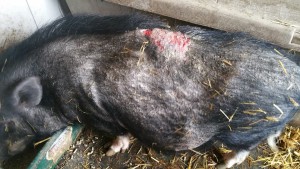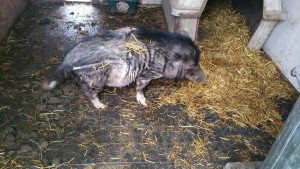
How do you handle irresponsible stories about pet pigs? You educate. Recently, we were made aware of a story that aired on Fox news as well as shared to their many Facebook page feeds and added to their website. Naturally this story glamorized pigs and how small they stayed, the usual myths that are tossed around by uneducated people. I don’t blame Fox news entirely, but I do place some of the blame on them for not checking facts before airing such a ridiculous story. Despite the wealth of information available to people, unfortunately, they will believe what they want to believe. They will take bits and pieces from different websites and groups and come up with their own conclusion about pigs and this mythical micro pig.
http://www.fox10phoenix.com/news/arizona-news/micropigs. They likely didn’t mean to cause a riot, but I know I reached out to them privately as did several of my friends when we were alerted to this story. Thankfully, the news has reached out to several rescues and will be doing a story on the unwanted pigs across the US to counter the inaccurate story they already did. It is stories like this that cause a surge of people to run out and get a pig on a whim. We are the ones left to network and find homes in a few months, once the novelty wears off. Rescues do not have any more room for any more pigs. People do not have any more room in their homes for any more pigs. Shelters aren’t equipped to handle pigs, craigslist isn’t a place that I would ever suggest a person to try and rehome their pig on. It has gotten so out of control, and this is only February, the pigs that were bought as Christmas gifts are about to start being rehomed in the next month or so too….stories like this do not help the already overpopulated pig problem. If you are considering getting a pig for you and your family, please go check out a pig rescue. Volunteer for a day. Get to see firsthand what having a pig is like. You may even see the big ball of fun that was destined to live with you right there at that rescue. But, don’t believe the lies. Trust your science community who have come up with actual breeds of pigs. Trust your universities who have done extensive research to be sure you are fully informed about what you are getting yourself in to. Trust the pig rescues that bring these unwanted/unloved pigs to their homes when they “grow too big” or are much different than what these people expected when they brought these pigs home. (Click here to see a list of pig rescues all over the world) These are the people who KNOW the truth and have evidence to support their way of thinking.
Anyone in pig world knows there is NO breed called teacup or micro or micro-mini. These terms are used to market these pigs and often mislead people into thinking they’re getting something that they aren’t. They’re going to end up disappointed with what they find several years later, especially if they have unrealistic expectations. If you were to buy a BMW car only to find out in 5 years that it was a mini-van, you would probably be quite disappointed. Essentially telling people that these pigs will stay piglet size is doing just that. While we understand there are a few pigs out there that have stayed relatively small, they are the exception and not the rule. Let me add, the overall well-being of these pigs is also in question, especially after hearing the “expert” on the segment refer to these pigs as micro pigs, and the fact that you can see their bone structure indicates to me that they should weigh more than they do.
If the weight of a pet is the most important factor when choosing what type you want to add to your family, then you should reconsider getting a pig. Pigs come in all shapes and sizes. Some are tall, some are long, others are short. Some pigs are fat, some are healthy and some are, simply put, starved.
Signs that a pig may be starving?
-Head is to large for their body
-Sunken (hallow) eyes
-Gap under their chin (if you run your hand under their chin you will feel an indentation)
-Low energy (no zoomies)
-Pigmentation of their skin is off
-Legs tend to bow
-Resting their head on objects *this was a huge thing for me as that made me think, wait, MY pig does that!
-Hair is thinner and rougher
-Hair doesnt lie flat
-Staggered gait or unsteady gait
-Poor skin and coat
-Pigs can also get super hairy when they’re underweight too because the body is trying to compensate for the lack of body fat as well. So lack of hair or a lot of hair, both can point to a pig being underweight.
-Some pigs gait is affected by the malnourishment and they’re not able to walk straight, often falling or they have a walking disorder such as goose-stepping due to vitamin/nutritional deficiencies, some can’t walk at all
-Eyes may have a glazed look or have a sadness to them
-Backbone tends to curve upwards leaving a hunched-over stance
-Bones visible through the skin. You should not be able to identify the skeletal structure from looking at a pig
These aren’t the only signs, but these are clear identifiable signs that a pig is being starved. Starving pigs is a cruel way to stunt the growth. They may not show immediate signs of being starved, but eventually they will. There are no healthy, fully mature pigs under 50 pounds that I am aware of to date. There are no breeders that can consistently produce pigs that stay small. There may be breeders who claim they do, they may even have a pig or two that have a smaller stature and that is typically what they focus on…those particular pigs. Do you know why people with these smaller pigs are discussed with such passion from those in the pig community? Because the pigs do NOT look healthy. I don’t care what your vet has said, I don’t care what you might think, when you can see the bones in the face, that pig is starved. Most pigs that are moderately starved will start to have behavioral issues, attacking or acting aggressive due to not getting enough to eat. This is a fairly common reaction. People who have to fight for food are the same, they’ll do whatever they can in order to secure nourishment for their body. Some of these pigs are so starved, I highly doubt they have the energy to attack anyone.
Are smaller pigs somehow better than bigger pigs? I don’t think so. Having a pig that is smaller can certainly have its’ benefits, but an angry and sad starving pig? I just don’t see the glamour in that. Having a small pig isn’t worth the toll it takes on my pigs body. There is a huge gray area where body scoring is concerned. Fat pigs aren’t any fun either, but a fat pig at least has the joy of eating, obviously these starving pigs have been denied that pleasure. When a pig doesn’t get the appropriate amount of nutrition, there is a domino effect. The body can’t grow like its supposed to leaving growth that is significantly stunted. The bones need nutrients found in correct amounts of feed, when this is not being given, these bones are weak and can become easily deformed. Sometimes these bones aren’t strong enough to support the weight or begin to bow leaving disfigured legs or backbones and taking the ability to walk away from these pigs. These pigs suffer from broken bones or easily fracture their extremities. The lack of proper nutrition also takes a toll on the lymphatic system rendering the immune system worthless. These pigs will likely get sick often or won’t be able to fight off common viruses or bacteria that other pigs can carry and never suffer effects from. These same illnesses can claim the life of starved pigs. The organs contained within the pigs body rely on nutrition to help them perform their duties within the body and although they will take the nutrients they can get, eventually, the capacity to function as they’re supposed to will diminish.
Starvation is one of the most deadly conditions on the planet; according to some studies, the effects of starvation play a major role in between one-third and one-half of all worldwide deaths of children under the age of five. The same rule applies to pigs. By depriving the body of nutrition, starvation slowly allows the body to devour its own reserves, including muscle, fat, and organs, up to the point of complete system shut-down and death. Understanding how starvation affects the body is important to recognizing the signs of malnutrition and preventing a growing nutrition-based problem from worsening beyond repair.
The body is an effective storage device for fats, nutrients, and other important components. These stores are regulated by nutrition in the form of food, beverages, and vitamin and mineral supplements. When lack of nutrition occurs, the body quite quickly turns to stored reserves, beginning with glycogen, in order to keep vital functions up to par. As the body begins to devour more and more stored components to keep running, the physical effects of starvation become apparent.
One of the first effects of starvation to occur is a drop in metabolism. In order to maximize efficiency, the body protects its insulating fat stores by consuming muscle stores instead, using these reserves to make up for the lack of calorie intake. Dropping metabolism can lead to feelings of fatigue, decreased capacity for activity, and mental sluggishness. This often results in staggering gait or neuro-like symptoms as well. This is sometimes visible early on, but sometimes the long term effects are not immediately identified.
Since the body is busy keeping vital systems going, many non-vital functions slow or cease. Hormone production is often disrupted, Intact pigs may stop menstruating entirely, or experience erratic heat cycles. Malnutrition and starvation, therefore, can have serious developmental effects, even after recovery (if this is rectified), as normal hormonal functions may be temporarily or permanently thrown off track.
The effects of starvation on the brain cause a lack of concentration, loss of motor skills, and increased likelihood of anxiety and depression. As the condition progresses, brain function decreases, leaving the victim, in this case, a pig, in a state of fatigue or torpor. Apathy continues to increase, until the pig may no longer be able to attempt to find food or survive.
Initial weight loss will quickly turn to emaciation because of the effects of starvation. The limbs become extremely thin as muscle and fat stores are depleted, while the eyes and face begin to appear sunken. Lack of vital proteins can lead to the loss of hair, poor skin condition or development of edemas, which appear as large swollen areas. The stomach may protrude enormously, as part of a syndrome known as kwashiorkor. This can present as a bloated belly and even mimic the appearance of a large belly in general. (See the video below for examples)
Starvation is frequently a result of uneducated people who have chosen to do this on purpose, but there have been times people have been told to feed extremely restricted diets by the very person who told them there was such a thing as a “micro” pig. While the effects can often be reversed up to a point, acute starvation can cause serious organ damage and often leads to long-term health conditions including cardiovascular problems. If a pig, particularly a piglet, is exhibiting signs of starvation, it is important to try and intervene. Perhaps this person doesn’t know the long term effects of malnutrition? Maybe they do and have chosen this as a way to attempt to keep a pig at a particular size, but that is called abuse. Unattended, starvation leads inexorably towards death. Not necessarily immediate death, but the effects from long term starvation WILL ultimately lead to death. Educate, educate, educate. Anything can be said tactfully without a hostile undertone. There may even be circumstances you’re not aware of, such as a pig being recently rescued from horrific situations, so be sure to ask and not accuse if you are truly trying to help.
Starving pigs is causing psychological harm, although the degree of severity can be hard to truly determine. A pig trusts its human caretaker. By taking away the one things pigs love…food…essentially you have robbed them of their one achievable desire. What kinds of psychological harm do animals suffer?
Rejecting: an active refusal to provide emotional support
Terrorizing: the creation of a “climate of fear” or an unpredictable threat or hostility, preventing the victim from experiencing a sense of security.
Taunting: teasing, provoking, harassing.
Isolating: active prevention of social interactions and companionship.
Abandonment: desertion and termination of care.
Over-pressuring: placing excessive demands or pressure to perform and achieve.
Starving a pig can fall into many of these categories. It may not be based on the descriptions above, but terrorizing and taunting comes to mind right off the bat. Knowingly limiting the amount of food your pig is able to eat in a way to “keep your pig small” is not only ignorant, but also abuse.
Here are a few pictures of pigs that were starved.
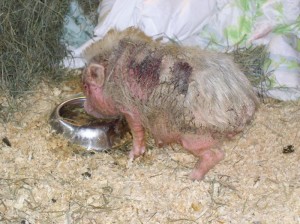
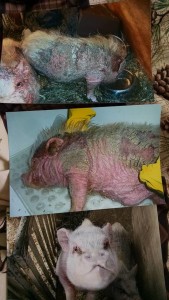
This is Jack Jack before and after. How can anyone ever think this was a healthy pig?
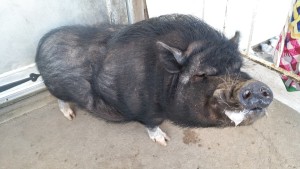
This is Oscar’s before and after pictures who was thankfully saved by Katherine Wilson.
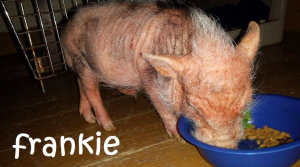
Frankie is a special pig who was thankfully rescued!
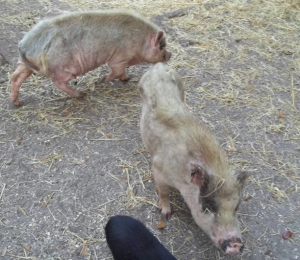
These pigs came from a pig rescue that is no longer around. They are now at a great rescue and thriving in their new happy/healthy lives!
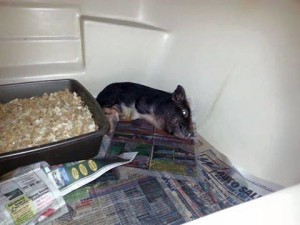
This is sweet Sophie. Sophie was starved and forced to live in a bathtub her entire life. Poor Sophie was not able to survive her injuries and passed away. The sad part is that her former owners didn’t see a problem. She was not only severely malnourished, but also suffered multiple fractures from attempting to jump out of the bathtub she was forced to live in.
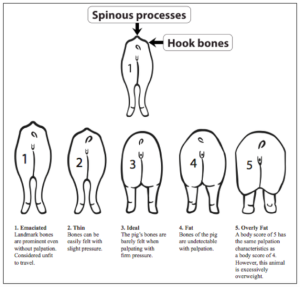
These charts are NOT intended for piglets, but more for pigs over a year old…however, if your pig is a number 1, your pig needs to gain some weight regardless of the age. STOP STARVING PIGS TO KEEP THEM SMALL!!!!!! You will never get respect for abusing your pig, not from us or any respectable organization that actually cares about pigs. Big pigs are beautiful. There are no recognized breeds named teacup or micro. Check out the links below to see the sources, they are universities and the science community’s research studies. These are credible resources, not just some person who said so. Don’t let your selfish desires outweigh the needs of a pig. Many are simply not equipped or prepared to bring one home and do so anyways.
Additional helpful links:
https://www.thedodo.com/big-is-beautiful
http://www.skippingkunekunes.com/jack__jill
Realistic sizes of pigs from real owners
Guide to nutrition
NAPPA does NOT support, endorse or condone anyone that starves a pig in an attempt to keep a pig small. This is not only cruel, but also abuse. Do NOT restrict feed to try and limit your pigs ability to grow. This will always have a negative outcome.
